从颜色词看中英文化差异
中英文化中词语颜色的差异
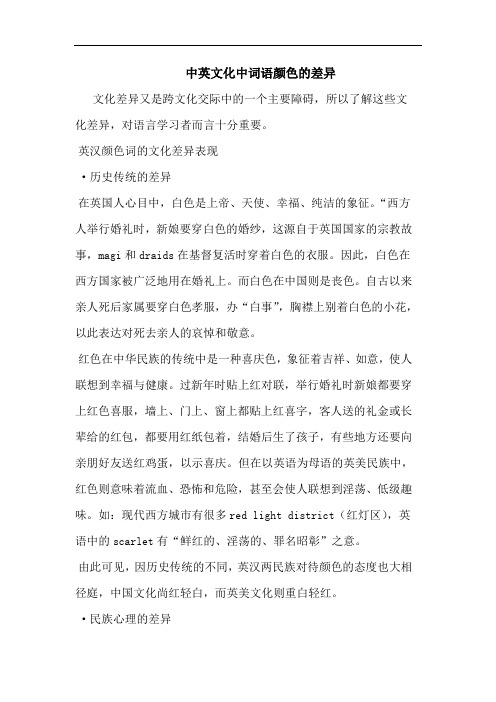
中英文化中词语颜色的差异文化差异又是跨文化交际中的一个主要障碍,所以了解这些文化差异,对语言学习者而言十分重要。
英汉颜色词的文化差异表现·历史传统的差异在英国人心目中,白色是上帝、天使、幸福、纯洁的象征。
“西方人举行婚礼时,新娘要穿白色的婚纱,这源自于英国国家的宗教故事,magi和draids在基督复活时穿着白色的衣服。
因此,白色在西方国家被广泛地用在婚礼上。
而白色在中国则是丧色。
自古以来亲人死后家属要穿白色孝服,办“白事”,胸襟上别着白色的小花,以此表达对死去亲人的哀悼和敬意。
红色在中华民族的传统中是一种喜庆色,象征着吉祥、如意,使人联想到幸福与健康。
过新年时贴上红对联,举行婚礼时新娘都要穿上红色喜服,墙上、门上、窗上都贴上红喜字,客人送的礼金或长辈给的红包,都要用红纸包着,结婚后生了孩子,有些地方还要向亲朋好友送红鸡蛋,以示喜庆。
但在以英语为母语的英美民族中,红色则意味着流血、恐怖和危险,甚至会使人联想到淫荡、低级趣味。
如:现代西方城市有很多red light district(红灯区),英语中的scarlet有“鲜红的、淫荡的、罪名昭彰”之意。
由此可见,因历史传统的不同,英汉两民族对待颜色的态度也大相径庭,中国文化尚红轻白,而英美文化则重白轻红。
·民族心理的差异民族心理就像一条幽暗的地下长流,涌动在一个民族意识的岩层里,流贯在该民族的血脉中。
中西方人们的心理因素及看待问题的方式,往往存在着种种差异。
英汉民族中,不同的颜色词可能用于描述同一种物质的客观表象。
英语说black tea,汉语说“红茶”。
为什么同样的一种茶被描述成了不同的颜色?英国人着眼于茶叶的颜色,称其为“黑”,而中国人则着眼于茶水的颜色,称其为“红”,这是由于两民族之间观察事物的角度不同,看似矛盾的东西,其实并不矛盾。
再如,yellow(黄色)一词,黄色在中国封建社会里是法定的尊色,象征着皇权、辉煌和崇高。
英汉颜色词所表现的中西文化差异

英汉颜色词所表现的中西文化差异一、本文概述颜色,作为自然界中普遍存在的现象,不仅在我们的日常生活中扮演着重要的角色,而且在各种文化和语言中也有着深远的象征意义。
本文旨在探讨英汉两种语言中的颜色词所反映的中西文化差异。
我们将通过对英汉颜色词的分类、历史演变和象征意义的研究,来揭示这些颜色词在不同文化背景下的独特内涵和深远影响。
我们将对英汉颜色词进行分类,比较两种语言中的颜色词在数量和种类上的差异,以及这些颜色词在各自语言中的地位和重要性。
然后,我们将探讨英汉颜色词的历史演变,了解这些颜色词在不同历史时期的文化内涵和象征意义。
接下来,我们将重点分析英汉颜色词的象征意义,以及这些象征意义在不同文化背景下的差异。
我们将通过具体的例子,如红色、白色、黑色等颜色词,来展示它们在英汉两种语言中的不同象征意义,以及这些象征意义如何影响人们的思维方式和行为习惯。
我们将总结英汉颜色词所反映的中西文化差异,并探讨这些差异对跨文化交流和理解的影响。
我们希望通过本文的研究,能够帮助读者更好地理解不同文化背景下的颜色词,从而加深对中西文化差异的理解和认识。
二、颜色词在中西方文化中的象征意义颜色词在英汉两种语言体系中,除了基本的指称功能外,还承载着丰富的象征意义。
这些象征意义往往源于各自文化的历史、传统、习俗和宗教信仰,因此,在理解和运用颜色词时,我们需要深入了解其背后的文化内涵。
在中国文化中,红色是最具象征意义的颜色之一。
它通常与喜庆、吉祥、繁荣和尊贵相关联,如春节的红包、婚礼的红妆和皇帝的龙袍等。
红色还象征着革命和进步,这在中国的近代历史中得到了充分体现。
相比之下,在西方文化中,红色往往与危险、愤怒、热情和爱情等情感相关联,如红灯区的标志、斗牛士的红布和情人节的玫瑰等。
白色在中国文化中,常常与纯洁、高雅和哀思相联系,如白色的婚纱、白色的百合花和葬礼上的白花等。
然而,在西方文化中,白色则更多地与纯洁、神圣和和平相关,如新娘的婚纱、教堂的天花板和和平鸽的羽毛等。
英文本科毕业论文《从颜色词看中英文化差异》.doc

从颜色词看中英文化差异摘要我们生活在五彩缤纷、五颜六色的世界中,颜色的多样性造成了与之相对应的颜色词的丰富多彩。
颜色词除了可以表示最基本的大自然绚丽色彩的意义以外,在某种程度上也体现了人类的一些价值观和审美观。
在这种情况下,颜色词已不单纯是表示客观颜色的指称意义了,而是被赋予了不同的象征意义,而不同文化背景的人们对颜色的感知和审美体验是同中有异,异中有同。
本文将选取几个典型的颜色词来分析颜色词在中英文化中所存在的共性和差异性,探讨形成这种差异性的各种原因,并浅略讲述其对跨文化沟通、交流的影响及解决办法。
关键词:颜色词联想意义文化差异跨文化交际Chinese and English Cultural Differences Reflected in the ColorTermsAbstractAs we live in a colorful world, the diversity of colors results in the diversity of the equivalent color terms. Apart from expressing the most basic colors in the nature, colors, to some extent, represent some values and aesthetics of the mankind. In this case, color terms no longer merely express the designative meaning of the objective colors. They are given different symbolic meanings. People with different cultural background have different perceptions and aesthetic experience about colors, in which similarities can be found.This paper will select a few typical color terms to analyze the similarities and differences of color terms in Chinese and English cultures, discuss various reasons for these similarities, and touches upon their influence on the cross-cultural communication and exchanges and the solutions.Key words:color terms, associative meaning, cultural differences, cross-cultural communication目录引言 (1)1、中英两种文化中的颜色词及在跨文化交际中的翻译误区 (1)1.1、中英两种文化中的颜色词 (1)1.2、跨文化交际中颜色词的翻译误区 (1)2、颜色词在中英文化中的不同内涵,其共性与差异性 (1)2.1、白色(white) (2)2.2、红色(red) (2)2.3、黄色(yellow) (3)3、颜色词在中英文化中形成差异性的原因 (3)3.1、文化差异的原因 (4)3.2、价值取向的原因 (4)3.3、思维方式的原因 (5)3.4、宗教方面的原因 (5)3.5、其它原因 (5)4、颜色词的差异性对跨文化交流的影响 (6)5、在跨文化交流中应如何正确理解和翻译颜色词 (6)5.1、直译法 (6)5.2、意译法 (6)5.3、更换颜色词的翻译法 (7)5.4、增加颜色词的翻译法 (7)6、结语 (7)7、参考文献 (8)从颜色词看中英文化差异引言色彩与人类的生活息息相关,是人类认识世界的一个重要领域。
从英语颜色词看中西文化差异

从英语颜色词看中西文化差异摘要:英语中存在着大量的、丰富多彩的颜色词,这些颜色词不仅被人们运用于社会文化生活的各个方面,更是体现了中西文化差异。
本文通过对英语颜色词的探讨,了解中西文化差异,从而对英语以及英语国家了解得更加透彻。
关键词:英语颜色词中西文化差异英语中存在着大量的颜色词,这些词反映了社会生活的方方面面,汉语中也存在着大量的颜色词,与我们的日常生活也息息相关、密不可分,通过对英语颜色词的探讨,可以看出中西方文化差异。
1 反映消极价值取向的英语颜色词1.1 红色英语中的red既有褒义也有贬义。
在英语词中,red多为贬义。
西方人眼中的“红色”,带有“危险”、“激进”、“流血”、“暴力”的价值取向,这大概与欧洲人的祖先是游牧部落有关,红色总是引起屠杀牲畜及生命的联想。
red battle 指血战、激战,red hand 指沾满鲜血的手,red vengeance 意为血腥复仇,see the red light表示大难临头。
汉语对红色的审美与英语有着根本的差异。
汉语中的红色只有褒义,象征革命、进步、喜庆等。
在中国,红色是十分喜庆、吉祥的颜色。
无论是国事还是家事,人们都喜欢使用红色。
五星红旗,党旗都是鲜红色的,代表的炎黄子孙的一腔热血与热情。
红色历来是我国传统的喜庆色彩。
1.2 蓝色英语中的“蓝色”基本上是一种消极的价值取向,含有“忧郁、暗淡、沮丧”的消沉心情,与汉语中的蓝色有很大的差异。
英语的许多含有blue 的词语含有贬义,如blue in the face 意为“动怒、变脸”,sing the blues意为“垂头丧气”,blue devils 是“忧愁”的意思,blue funk 则表示“难以控制的恐惧”,blue run具有“大失败”的含义, blue sky 表示“不保险的”的语义,blue?Monday指“倒霉的星期一”,to?be?in?the?blues指“情绪低落、忧郁”,?blue?law指“禁止星期日饮酒、娱乐的法规”。
“黑”、“白”颜色词的英汉文化内涵差异
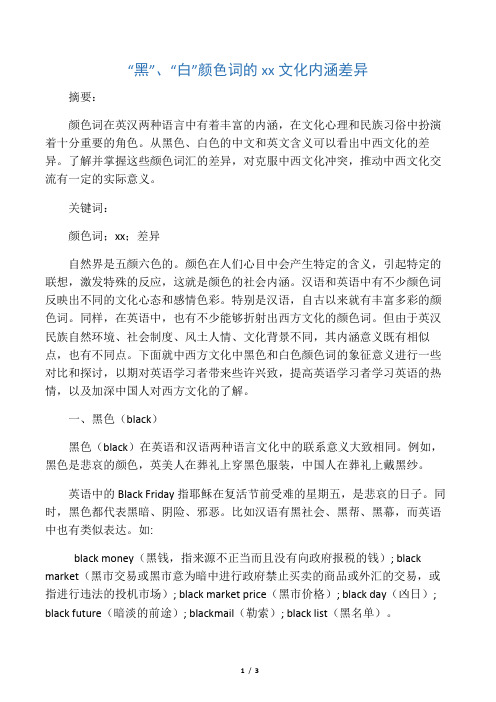
“黑”、“白”颜色词的xx文化内涵差异摘要:颜色词在英汉两种语言中有着丰富的内涵,在文化心理和民族习俗中扮演着十分重要的角色。
从黑色、白色的中文和英文含义可以看出中西文化的差异。
了解并掌握这些颜色词汇的差异,对克服中西文化冲突,推动中西文化交流有一定的实际意义。
关键词:颜色词;xx;差异自然界是五颜六色的。
颜色在人们心目中会产生特定的含义,引起特定的联想,激发特殊的反应,这就是颜色的社会内涵。
汉语和英语中有不少颜色词反映出不同的文化心态和感情色彩。
特别是汉语,自古以来就有丰富多彩的颜色词。
同样,在英语中,也有不少能够折射出西方文化的颜色词。
但由于英汉民族自然环境、社会制度、风土人情、文化背景不同,其内涵意义既有相似点,也有不同点。
下面就中西方文化中黑色和白色颜色词的象征意义进行一些对比和探讨,以期对英语学习者带来些许兴致,提高英语学习者学习英语的热情,以及加深中国人对西方文化的了解。
一、黑色(black)黑色(black)在英语和汉语两种语言文化中的联系意义大致相同。
例如,黑色是悲哀的颜色,英美人在葬礼上穿黑色服装,中国人在葬礼上戴黑纱。
英语中的Black Friday指耶稣在复活节前受难的星期五,是悲哀的日子。
同时,黑色都代表黑暗、阴险、邪恶。
比如汉语有黑社会、黑帮、黑幕,而英语中也有类似表达。
如:black money(黑钱,指来源不正当而且没有向政府报税的钱); black market(黑市交易或黑市意为暗中进行政府禁止买卖的商品或外汇的交易,或指进行违法的投机市场); black market price(黑市价格); black day(凶日); black future(暗淡的前途); blackmail(勒索); black list(黑名单)。
但是,黑色在英语和汉语中也有不同的含义。
黑色在中国古代象征尊贵、刚毅、严正、铁面无私、憨直、神秘等褒义。
在戏剧脸谱中,往往用黑色脸谱象征人物的刚直不阿、严正无私或憨直的性格。
中西方颜色词象征意义差异的原因

中西方颜色词象征意义差异的原因【篇一:中西方颜色词象征意义差异的原因】英汉颜色词差异的主要原因是由于英汉民族所处的地理位置历史背景,所拥有的风俗习惯、民族心理和思维方式存在着很大差异.西方从文明一开始,就比较注重科学理性的教育和科学方法的发现,对客观世界和客观认识采取现实的科学态度.因此,西方文化中颜色的象征意义往往比较直接,一般是用客观事物的具体颜色来象征某些抽象的文化含义,所以更易追溯其语义理据和逻辑理据.例如:西方文化中的红色(red)主要指鲜血(blood)颜色,而blood在西方人心目中是奔腾在人体内的生命之液.一旦鲜血流淌下来,生命之花也就凋谢.所以red使西方人联想到暴力和危险产生了一种颜色禁忌.美国学者阿思海姆在他的《色彩论》中说:色彩能有力的表达情感.……红色被认为是令人激动的,因为它能使我们想到火、血和革命的含义.著名汉学家霍克斯在翻译红楼梦时,由于意识到red可能使现代英语读者联想到“暴力、流血,所以采用小说原来曾使用的书名《石头记》,译为the story of the stone.但是由于中国经历了几千年的封建社会以及教育和科技的相对落后,在中国文化中,颜色的生成具有强烈的神秘色彩,它的发展受到中国社会文化发展的较大影响.在先秦,颜色词就已经和古人的世界观、哲学思想联系在一起,后来又和政治挂钩.所以中国文化中的颜色内涵和象征意义十分丰富,而且颜色词的象征意义是多元的.2、白色在中国文化中,白色和红色相反,是一个基本禁忌词,体现了中国人在物质和精神上的摈弃和厌恶.在中国古代的五方说中,西方为白虎,西方是刑天杀神,主萧杀之秋,古代常在秋季征伐不义、处死犯人.所以白色是枯竭而无血色、无生命的表现,象征死亡、凶兆.如自古以来亲人死后家属要披麻戴孝(穿白色孝服)办白事,要设白色灵堂,出殡时要打白幡;旧时还把白虎视为凶神,所以现在称带给男人厄运的女人为白虎星.白色的心理功能在其发展过程中由于受到政治功能的影响,又象征腐朽、反动、落后,如视为白专道路;它也象征失败、愚蠢、无利可得,如在战争中失败的一方总是打着“白旗” 表示投降,称智力低下的人为白痴,把出力而得不到好处或没有效果叫做白忙、白费力、白干等,它还象征奸邪、阴险,如唱白脸、白脸奸雄;最后,它还象征知识浅薄、没有功名,如称平民百姓为白丁、白衣、白身,把缺乏锻炼、阅历不深的文人称作白面书生等.西方文化中的白色象征意义主要着眼于其本身色彩,如新下的雪、新鲜牛奶及百合花的颜色.西方人认为白色高雅纯洁,所以它是西方文化中的崇尚色.它象征纯真无邪,如(1)a white soul纯洁的心灵,(2)wh ite wedding新娘穿白礼服的婚礼;它又象征正直、诚实,如(1)a white spirit正直的精神, (2)whitem en高尚、有教养的人,(3)white hand廉洁、诚实;它也象征幸运、吉利,如(1)one ofthe white days o f sbs life 某人生活中的吉日之一,(2)whitemagic有天使相助的法术;它还有合法、无恶意的意思,如( 1) whitemarket合法市场,(2)white list经过批准的合法明单,(3)awhite lie 无害的谎言.【篇二:中西方颜色词象征意义差异的原因】逻辑的同一无法掩盖文化的差异。
从颜色词看中西文化差异
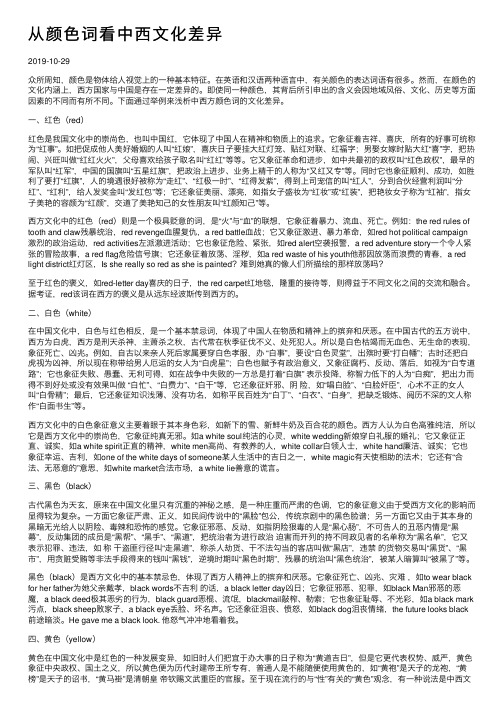
从颜⾊词看中西⽂化差异2019-10-29众所周知,颜⾊是物体给⼈视觉上的⼀种基本特征。
在英语和汉语两种语⾔中,有关颜⾊的表达词语有很多。
然⽽,在颜⾊的⽂化内涵上,西⽅国家与中国是存在⼀定差异的。
即使同⼀种颜⾊,其背后所引申出的含义会因地域风俗、⽂化、历史等⽅⾯因素的不同⽽有所不同。
下⾯通过举例来浅析中西⽅颜⾊词的⽂化差异。
⼀、红⾊(red)红⾊是我国⽂化中的崇尚⾊,也叫中国红,它体现了中国⼈在精神和物质上的追求。
它象征着吉祥、喜庆,所有的好事可统称为“红事”。
如把促成他⼈美好婚姻的⼈叫“红娘”,喜庆⽇⼦要挂⼤红灯笼、贴红对联、红福字;男娶⼥嫁时贴⼤红“喜”字,把热闹、兴旺叫做“红红⽕⽕”,⽗母喜欢给孩⼦取名叫“红红”等等。
它⼜象征⾰命和进步,如中共最初的政权叫“红⾊政权”,最早的军队叫“红军”,中国的国旗叫“五星红旗”,把政治上进步、业务上精⼲的⼈称为“⼜红⼜专”等。
同时它也象征顺利、成功,如胜利了要打“红旗”,⼈的境遇很好被称为“⾛红”、“红极⼀时”、“红得发紫”,得到上司宠信的叫“红⼈”,分到合伙经营利润叫“分红”、“红利”,给⼈发奖⾦叫“发红包”等;它还象征美丽、漂亮,如指⼥⼦盛妆为“红妆”或“红装”,把艳妆⼥⼦称为“红袖”,指⼥⼦美艳的容颜为“红颜”,交道了美艳知⼰的⼥性朋友叫“红颜知⼰”等。
西⽅⽂化中的红⾊(red)则是⼀个极具贬意的词,是“⽕”与“⾎”的联想,它象征着暴⼒、流⾎、死亡。
例如:the red rules of tooth and claw残暴统治,red revenge⾎腥复仇,a red battle⾎战;它⼜象征激进、暴⼒⾰命,如red hot political campaign 激烈的政治运动,red activities左派激进活动;它也象征危险、紧张,如red alert空袭报警,a red adventure story⼀个令⼈紧张的冒险故事,a red flag危险信号旗;它还象征着放荡、淫秽,如a red waste of his youth他那因放荡⽽浪费的青春,a red light district红灯区,Is she really so red as she is painted?难到她真的像⼈们所描绘的那样放荡吗?⾄于红⾊的褒义,如red-letter day喜庆的⽇⼦,the red carpet红地毯,隆重的接待等,则得益于不同⽂化之间的交流和融合。
浅析中英文中颜色词的文化差异
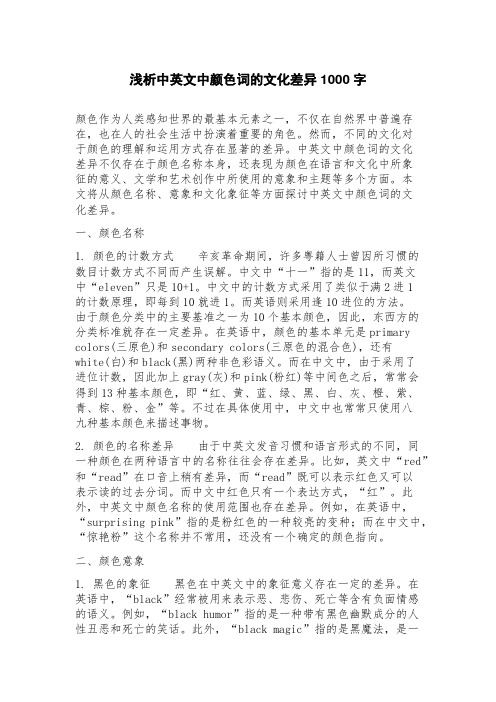
浅析中英文中颜色词的文化差异1000字颜色作为人类感知世界的最基本元素之一,不仅在自然界中普遍存在,也在人的社会生活中扮演着重要的角色。
然而,不同的文化对于颜色的理解和运用方式存在显著的差异。
中英文中颜色词的文化差异不仅存在于颜色名称本身,还表现为颜色在语言和文化中所象征的意义、文学和艺术创作中所使用的意象和主题等多个方面。
本文将从颜色名称、意象和文化象征等方面探讨中英文中颜色词的文化差异。
一、颜色名称1. 颜色的计数方式辛亥革命期间,许多粤籍人士曾因所习惯的数目计数方式不同而产生误解。
中文中“十一”指的是11,而英文中“eleven”只是10+1。
中文中的计数方式采用了类似于满2进1的计数原理,即每到10就进1。
而英语则采用逢10进位的方法。
由于颜色分类中的主要基准之一为10个基本颜色,因此,东西方的分类标准就存在一定差异。
在英语中,颜色的基本单元是primary colors(三原色)和secondary colors(三原色的混合色),还有white(白)和black(黑)两种非色彩语义。
而在中文中,由于采用了进位计数,因此加上gray(灰)和pink(粉红)等中间色之后,常常会得到13种基本颜色,即“红、黄、蓝、绿、黑、白、灰、橙、紫、青、棕、粉、金”等。
不过在具体使用中,中文中也常常只使用八九种基本颜色来描述事物。
2. 颜色的名称差异由于中英文发音习惯和语言形式的不同,同一种颜色在两种语言中的名称往往会存在差异。
比如,英文中“red”和“read”在口音上稍有差异,而“read”既可以表示红色又可以表示读的过去分词。
而中文中红色只有一个表达方式,“红”。
此外,中英文中颜色名称的使用范围也存在差异。
例如,在英语中,“surprising pink”指的是粉红色的一种较亮的变种;而在中文中,“惊艳粉”这个名称并不常用,还没有一个确定的颜色指向。
二、颜色意象1. 黑色的象征黑色在中英文中的象征意义存在一定的差异。
从颜色词看中西方文化差异

从颜色词看中西方文化差异41432054 李静人类世界色彩斑斓,光怪陆离,“赤橙黄绿青蓝紫”如一条五光十色的彩带为人类编织出光彩夺目的生态环境。
颜色作为一种感官认知,人类对其的认知有明显的共通之处,基本颜色词的含义在各个语言中应是相同的,但因东西方地理环境、历史传统、宗教信仰、价值观念、文化风俗、思维定势以及审美情趣等方面的不同,人们总是按照自己的思维定势和价值尺度去描绘事物的颜色,赋予词汇以本民族的文化内涵,带有显著的文化烙印。
不同国家对不同颜色赋予了不同的含义,因此对不同颜色的喜爱程度也不一样。
中国、朝鲜、印度、巴基斯坦、缅甸等国均喜爱红色、绿色、黄色等较鲜艳之色,而日本则尤爱素雅之色,并将绿色视为不详之色。
这些国家共同禁忌的颜色是黑色、灰色。
沙特阿拉伯、也门、伊朗、科威特和伊拉克等一些国家则喜欢绿色和深蓝色,忌讳的是大红色、紫色和黄色。
欧洲大多数国家都喜欢红色、蓝色,而禁忌黑色。
正因如此,人们对各种颜色词的判断就会产生偏误。
Mr. Brown is a very white man. He was looking rather green the other day. He has been feeling blue lately. When I saw him, he was in a brown study. I hope he’ll soon be in the pink again.(误译)布朗先生是个很白的人。
那天他脸上却有点绿色。
近来他一直感到蓝蓝的。
每当看到他时,他总是在棕色的学习中,我希望他早日处于粉红色之中。
(正译)布朗先生是个非常忠实可靠的人。
那天他脸上颇有病色。
近来他一直感到闷闷不乐。
每当我看到他时,他总是处在极度深思之中,我希望他早日恢复健康。
由此可以看出,简单的颜色词在不同的文化背景下竟然有如此大的差别。
本文以在文化中差异较大的红白两色为例,分析中西方文化差异。
红色在中西方文化中是差异较大的一个颜色。
浅析中英颜色词中的文化差异
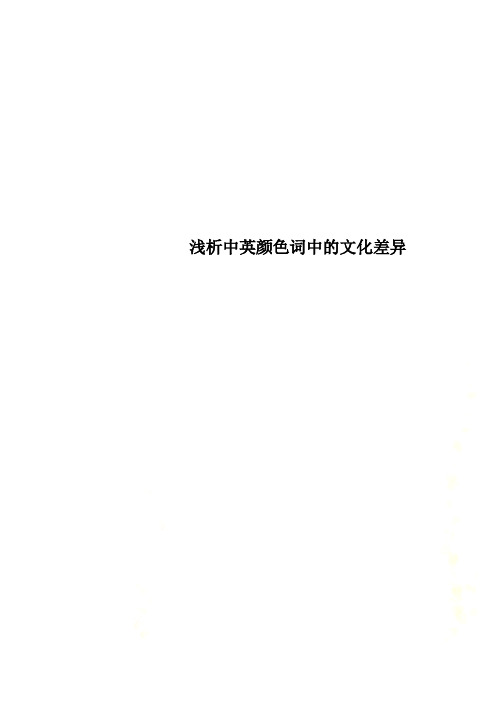
浅析中英颜色词中的文化差异浅析中英颜色词中的文化差异摘 要:颜色词是每个民族文化中的重要组成部分。
由于地域、风俗、政治、宗教及价值观等方面的不同,中英文中相互对应的颜色词往往代表着不同的含义,本文将基于颜色词产生的文化背景,对汉英颜色词的文化差异进行分析,以便更好地理解不同的民族及文化背景对语言产生的影响力,避免在跨文化交流中产生文化冲突。
关键词:颜色词;原因;内涵;文化差异一、引言我们生活在一个五彩缤纷的世界里,人类对色彩的感觉是普遍相同的。
但是, 颜色一旦用于人类社会的交际活动, 在人们心目中就会产生特定的含义,引起特殊的联想, 激发特别的感情。
英语和汉语中都有许多表示颜色的词语,它们的表层含义具有一致性,但由于中西方地理环境,历史文化、民族习惯、思维模式、宗教信仰等文化因素的不同,人们便总是按照自己的思维定势和价值尺度赋予描绘事物的颜色词本民族独特的文化内涵,这样就导致了人们对各种颜色的价值判断和实际运用的巨大差异[1]。
语言学家萨丕尔在《语言论》一书中曾指出:“语言有一个环境”、“语言不能脱离文化而存在”[2]。
词汇是语言的基本组成部分,是文化信息的载体,各种各样的文化特征,都能在词汇中反映出来,而颜色词作为词汇海洋的一部分,也能从不同角度折射出中英文化的差异。
本文将从各颜色词产生的文化背景来剖析红、黄、白、黑、绿、蓝等颜色词不同的文化内涵,从而正确掌握颜色词在英汉两种语言中的深层含义,避免跨文化交际的失误。
二、汉英颜色词中的文化差异 随着经济全球化趋势的加强,中西方文化交流也不断增强,因而跨文化交际就起着非常重要的作用。
“跨文化交际指本族语者与非本族语者之间的交际,也指任何在语言和文化背景方面有差异的人们之间的交际。
通俗来说就是如果你和外国人打交道,由于存在语言和文化背景的差异,应该注意什么问题,应该如何得体地去交流。
英国语言学家托马斯(Thomas ,1983)将语用失误分为两类:一类是语言本身的语用失误(pragmatic-linguistic failure ),另一类是社交语用失误(social-pragmatic failure )。
浅析颜色词在中西方文化中的差异

浅析颜色词在中西方文化中的差异一、本文概述颜色,作为一种视觉感知的基本元素,不仅在日常生活中扮演着重要的角色,而且在文化、艺术、心理等多个领域都具有深远的影响。
在不同的文化背景下,颜色词所承载的含义和象征意义往往有着显著的差异。
本文旨在浅析颜色词在中西方文化中的差异,揭示这些差异背后的文化、历史和心理因素,以期增进人们对不同文化背景下颜色词的理解和认知。
本文将首先介绍颜色词在中西方文化中的基本含义和象征意义,然后从文化、历史和心理三个层面探讨这些差异产生的原因。
在文化层面,我们将分析不同文化背景下颜色词的象征意义及其背后的文化内涵;在历史层面,我们将追溯颜色词在中西方历史中的演变过程,探讨其背后的历史背景和社会变迁;在心理层面,我们将分析颜色词对个体心理的影响,以及它们在跨文化交流中的心理效应。
通过本文的论述,我们希望能够为读者提供一个全面了解颜色词在中西方文化中差异的视角,帮助读者更好地理解和适应不同文化背景下的颜色词使用,进而促进跨文化交流和理解。
二、颜色词在中西方文化中的基本含义颜色词在中西方文化中扮演着重要的角色,它们不仅用来描述和区分不同的色彩,还承载着丰富的文化含义和象征意义。
这些含义和象征意义往往与人们的日常生活、历史传统、宗教信仰、审美观念等密切相关。
在中国文化中,红色被视为吉祥、繁荣和幸运的象征,常常用于庆祝重要节日和喜庆场合,如春节、婚礼等。
红色也代表着勇气、热情和活力,常被用于表达积极向上的情感和态度。
相反,在西方文化中,红色通常与危险、愤怒和暴力相关联,如在交通信号灯中,红色表示停止和危险。
在西方文化中,红色也常用来象征爱情和激情,如情人节和婚礼中常用的红色玫瑰。
白色在中国文化中通常与纯洁、宁静和哀思相联系。
它常被用于表达庄重、肃穆的情感,如在葬礼上穿着白色衣服以示哀悼。
而在西方文化中,白色通常象征着纯洁、无辜和神圣,常被用于教堂和婚礼等场合。
白色在西方文化中也代表着清新、简约和时尚,因此在时尚界中备受欢迎。
从颜色词看中西方文化异同

科技视界Science&Technology VisionScience&Technology Vision科技视界0引言我们生活在一个五彩缤纷的世界当中,特别是在近代工业革命以来化学工业的蓬勃发展也为颜色的多样性提供了有利条件。
颜色带给我们的不仅仅是视觉的享受,它也代表这一定的审美取向。
在东西方不同的文化氛围当中,颜色则被赋予了更多的意义,并由文化差异的载体语言呈现出来。
本文将会选取中英双语中具有代表性的颜色词,通过举例对东西文化异同进行简要分析。
1红色red红色在中华民族传统文化占有重要地位。
在中国,红色代表了吉祥,喜庆。
中国人婚丧嫁娶人们要送“红包”;过年要挂红灯笼;传统婚礼新人要穿大红色婚服,都代表了吉祥。
红色还代表成功,受欢迎。
某人在某项竞赛中取得佳绩,单位或学校要悬挂红色条幅或张贴”大红榜”来予以嘉奖;遇事开了个好头称之为“开门红”,明星受欢迎被称为“走红”,被上级欣赏的人叫“红人”。
除此之外红色还有逢凶化吉、弃恶扬善之意。
故宫等古代建筑群的城墙都被漆成红色,以此来趋吉避凶。
综上所述,中国人对红色的热爱无人能及,无论是新年还是国庆,全国山河一片红。
可以说红色是中国人的国色。
红色充斥着中国人生活的方方面面。
而西方却恰恰相反,red是个十分敏感甚至带有贬义的颜色。
说起red,西方人首先联想到的是“火”、“血”,代表暴力流血,紧张。
例如:red revenge代表血腥复仇,a red battle有血战之意,red ruin表示火灾。
red又象征激进、暴力革命,如a red revolution指赤色革命。
红色还象征危险紧张,如red alert空袭报警,a red flag危险信号旗;red light红灯等。
除此之外,red还象征放荡、淫秽,如a red waste of his youth他那因放荡而浪费的青春,a red light district红灯区。
红色在英语中还有亏损损失之意,如red figure,red ink都表示赤字,red balance指赤字差额,in the red指亏损。
从颜色词看中西方文化的差异
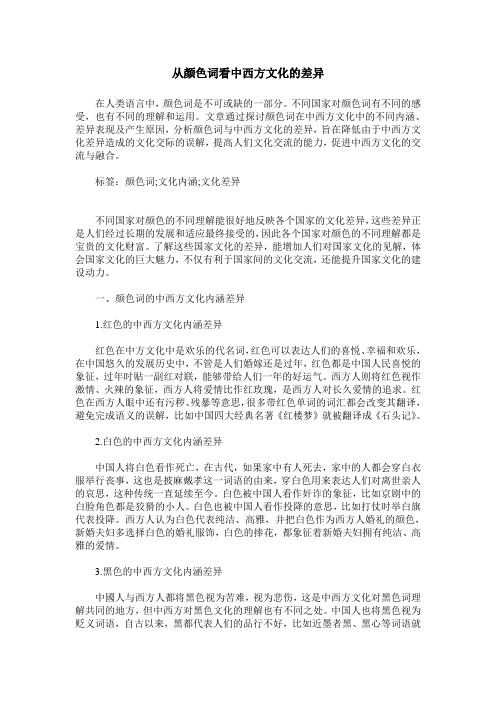
从颜色词看中西方文化的差异在人类语言中,颜色词是不可或缺的一部分。
不同国家对颜色词有不同的感受,也有不同的理解和运用。
文章通过探讨颜色词在中西方文化中的不同内涵、差异表现及产生原因,分析颜色词与中西方文化的差异,旨在降低由于中西方文化差异造成的文化交际的误解,提高人们文化交流的能力,促进中西方文化的交流与融合。
标签:颜色词;文化内涵;文化差异不同国家对颜色的不同理解能很好地反映各个国家的文化差异,这些差异正是人们经过长期的发展和适应最终接受的,因此各个国家对颜色的不同理解都是宝贵的文化财富。
了解这些国家文化的差异,能增加人们对国家文化的见解,体会国家文化的巨大魅力,不仅有利于国家间的文化交流,还能提升国家文化的建设动力。
一、颜色词的中西方文化内涵差异1.红色的中西方文化内涵差异红色在中方文化中是欢乐的代名词,红色可以表达人们的喜悦、幸福和欢乐,在中国悠久的发展历史中,不管是人们婚嫁还是过年,红色都是中国人民喜悦的象征,过年时贴一副红对联,能够带给人们一年的好运气。
西方人则将红色视作激情、火辣的象征,西方人将爱情比作红玫瑰,是西方人对长久爱情的追求。
红色在西方人眼中还有污秽、残暴等意思,很多带红色单词的词汇都会改变其翻译,避免完成语义的误解,比如中国四大经典名著《红楼梦》就被翻译成《石头记》。
2.白色的中西方文化内涵差异中国人将白色看作死亡,在古代,如果家中有人死去,家中的人都会穿白衣服举行丧事,这也是披麻戴孝这一词语的由来,穿白色用来表达人们对离世亲人的哀思,这种传统一直延续至今。
白色被中国人看作奸诈的象征,比如京剧中的白脸角色都是狡猾的小人。
白色也被中国人看作投降的意思,比如打仗时举白旗代表投降。
西方人认为白色代表纯洁、高雅,并把白色作为西方人婚礼的颜色,新婚夫妇多选择白色的婚礼服饰,白色的捧花,都象征着新婚夫妇拥有纯洁、高雅的爱情。
3.黑色的中西方文化内涵差异中國人与西方人都将黑色视为苦难,视为悲伤,这是中西方文化对黑色词理解共同的地方,但中西方对黑色文化的理解也有不同之处。
中英颜色词的文化差异
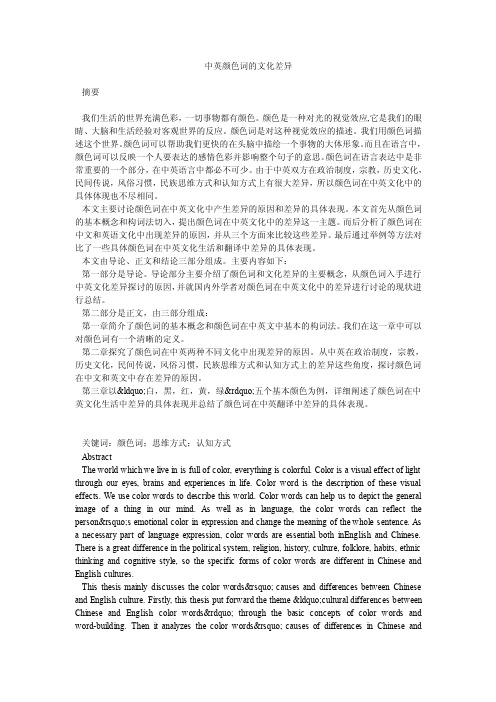
中英颜色词的文化差异摘要我们生活的世界充满色彩,一切事物都有颜色。
颜色是一种对光的视觉效应,它是我们的眼睛、大脑和生活经验对客观世界的反应。
颜色词是对这种视觉效应的描述。
我们用颜色词描述这个世界。
颜色词可以帮助我们更快的在头脑中描绘一个事物的大体形象。
而且在语言中,颜色词可以反映一个人要表达的感情色彩并影响整个句子的意思。
颜色词在语言表达中是非常重要的一个部分,在中英语言中都必不可少。
由于中英双方在政治制度,宗教,历史文化,民间传说,风俗习惯,民族思维方式和认知方式上有很大差异,所以颜色词在中英文化中的具体体现也不尽相同。
本文主要讨论颜色词在中英文化中产生差异的原因和差异的具体表现。
本文首先从颜色词的基本概念和构词法切入,提出颜色词在中英文化中的差异这一主题。
而后分析了颜色词在中文和英语文化中出现差异的原因,并从三个方面来比较这些差异。
最后通过举例等方法对比了一些具体颜色词在中英文化生活和翻译中差异的具体表现。
本文由导论、正文和结论三部分组成。
主要内容如下:第一部分是导论。
导论部分主要介绍了颜色词和文化差异的主要概念,从颜色词入手进行中英文化差异探讨的原因,并就国内外学者对颜色词在中英文化中的差异进行讨论的现状进行总结。
第二部分是正文,由三部分组成:第一章简介了颜色词的基本概念和颜色词在中英文中基本的构词法。
我们在这一章中可以对颜色词有一个清晰的定义。
第二章探究了颜色词在中英两种不同文化中出现差异的原因。
从中英在政治制度,宗教,历史文化,民间传说,风俗习惯,民族思维方式和认知方式上的差异这些角度,探讨颜色词在中文和英文中存在差异的原因。
第三章以“白,黑,红,黄,绿”五个基本颜色为例,详细阐述了颜色词在中英文化生活中差异的具体表现并总结了颜色词在中英翻译中差异的具体表现。
关键词:颜色词;思维方式;认知方式AbstractThe world which we live in is full of color, everything is colorful. Color is a visual effect of light through our eyes, brains and experiences in life. Color word is the description of these visual effects. We use color words to describe this world. Color words can help us to depict the general image of a thing in our mind. As well as in language, the color words can reflect the person’s emotional color in expression and change the meaning of the whole sentence. As a necessary part of language expression, color words are essential both inEnglish and Chinese. There is a great difference in the political system, religion, history, culture, folklore, habits, ethnic thinking and cognitive style, so the specific forms of color words are different in Chinese and English cultures.This thesis mainly discusses the color words’ causes and differences between Chinese and English culture. Firstly, this thesis put forward the theme “cultural differences between Chinese and English color words” through the basic concepts of color words and word-building. Then it analyzes the color words’ causes of differences in Chinese andEnglish culture, and compares these differences from three perspectives. Finally, by means of the examples and other methods, we compare the differences between some specific color words in our life and translation between Chinese and English culture.This thesis include three parts: an introduction, the main body and a conclusion. Its basic form are as follows:The introduction mainly introduces the background of the study on color words in Chinese and English culture and give a simple introduce of “color” and “cultural differences”. This part told us why I chose this proposition.The second part is the main body, which is made up of three chapters:Chapter One briefly introduces the color words’ basic concept and the word-building in Chinese and English. In this chapter, we can have a overall understanding of color words. Chapter Two focuses on the reasons of the differences of color words between Chinese and English culture from the angles of political system, religion, folklore, customs, habits, culture, ethnic thinking and cognitive style.Chapter Three takes “white, black, red, yellow and green” these five basic color words as the example, and expounds the specific expression of the color words’ differences in Chinese and English life, and summarizes the specific expression ofdifferences incolor words in translationbetween Chinese and English culture.Key Words: color word; ethnic thinking; cognitive styleContentsIntroduction 1Chapter IThe basic concept of color words 31. The basic concept of color words 32. The Word-Building of Color 3Chapter II The Causes of the Differences of Color Words in Chinese and English Cultures71. Political System, History,Culture and Religion 82. Folklore and Customs 103. Ethnic Thinking and Cognitive Style 11Chapter III The Specific Expression of Color Words in Chinese and English Culture 141. Color Words’ Differences Between Chinese and English Culture in Life 142. Color Words’Differences Between Chinese andEnglish Culture in Translation 18 Conclusion 20Bibliography 22Acknowledgements 23IntroductionColor is the reaction of the objective world for people, everything is colorful.Color is closely linked with people’s life.People is living in color. The founder of modern abstract art, Wassily Kandinsky, said in his book On Spiritual in Art, “Color directly affects thespirit” (Kandinsky, 1987). People product a lot of color words to express their feeling. These color words have many cultural connotations. We should pay attention to that in international communication, people’s perception to color symbols is different because they belong to different countries, different cultural backgrounds or belong to the same country and the same cultural background, but the members belong to different social groups or social classes. This kind of difference has a positive meaning in linguistics, which makes the color words have many associative meanings.Cultural difference refers to the differences between various regions’ people due to regional differences. There is a definition of culture that the “culture” is a common psychological process for the people who live in the same environment. This common psychological procedure will be diverse because people from different countries or regions are always influenced by different educations, different social and jobs which will have different ways of thinking.As a part of culture, language bears the important functions of noting and communication. Any human society can not exist without culture. Different cultures will present different cultural forms, and these differences which are reflected in the linguistic level is the language differences. Therefore, the color words rooted in the social culture because of their different growth of the soil, whose meaning contained in the information is not the same, thus forming a cultural difference. Cultural differences are the obstruction in international communication and translation, so it is very important for language learners to realize the causes and specific forms of cultural differences.Since 2008, there have been more and more researches on the differences between Chinese and English cultures areembodied in color words, and about twenty-five thousand papers have been published. There are a group of scholars such as Liu Hongquan and TianChuanmao to study this topic, they promote and lead the development and progress of the discipline.Chapter I The basic concept of color words1. The basic concept of color wordsColor is a kind of natural phenomenon. As the color of natural phenomena, it means “the impression which the light emits, reflects, or transmits through the object”(Jin Funian, 2003: 11). Describe this natural phenomenon’s words is color words.Color words can be divided into two types: descriptive color words and abstract color words in language. The words which only representsone color is abstract color words. For example, “red”, “green”, “yellow”,“blue”, “white” and “black”. And these words also exactly to be basic color words in English. But in Chinese, these five colors also belong to the “basic color words”. Although there are many differences between English and Chinese, and these two languages also have different cultural backgrounds. The number of basic color words in these two languages is roughly equal. Through the language, we can see the different cultural psychology and aesthetic taste of the English and Chinese peoples.American anthropologist Sapir in the Language said, “There are something behind the language, and the language can not leave without the culture. The existence of the culture is thesum of the legacy and the faith of society which can decide our life organization”(Sapir, 2002). It can be seen that the cultural practices of a socialgroup determine the way of life of a language group or nation, the way of cognition, the way of thinking and the value orientation. Therefore, there are significant differences between these two languages in color words.2. The Word-Building of Color“Both in English and Chinese, words are all composed of one or several morphemes. Morpheme is the smallest unit of language that carries information about meaning or function. Morphemes can be divided into two kinds: One is root,the root constitutes the core of the word and carries the major component of its meaning. The other is affix,affixes don’t belong to a lexical category and are always bound morphemes.”(Dai Weidong, He Zhaoxiong, 2002)According to the word-building, we can divide the English color words into three categories: One, simple color words are formed by a single root; Two, derived color words which consist of one root and one or several affixes; Three, synthetic color words which consist of more than two roots. Among them, the method of word-building of derived color words can be divided into four categories: adding method, overlapping method, mutation method and decremented method. According to the word-building, we can divide Chinese color words into two categories: One, simple color words which are formedby single morpheme;The other, synthetic color words consist of more than two morphemes. Amo ng them, the synthetic word’s word-building is divided into additional form, combined form and eclipsed form. In English, the add compose method and then add the prefix, infix or suffix to form a new word. Then in Chinese, the additional form is to attach the affix to the root to form a new word. From this point of view, the English affix method and the Chinese additional form is still similar in the actual vocabulary structure.We can compare the contrast of color words between English and Chinesein the w ord-building method through the English affix method and the Chinese additional form.A. English color word affix method: physical noun + adjectival suffix-y → adjectival color wordsWe take “snow” as an example. “Snow” is a noun, its basic meaning is “soft white pieces of frozen water that fall from the sky in cold weather and cover the ground”(Zheng Rongcheng, 1997).Take the sentence “the city was buried under four centimeters of snow” for example. In English, the suffix-y can be combined with the noun to form an adjective, then is also called the adjectival suffix. It often means “abound”. With the further understanding and expansion of human’s understanding of the world, people need a new kind of color word to describe something more image, more vivid description which has the same color and shiny as the snow. So people add the suffix-y after the physical term to constitute a new word “snowy” to describe this color. Because it adds the adjectival suffix-y after the physical term “snow”, “snowy” is defined as a adjective. The basic meaning of “snowy” is marked by the presence of snow. For example, “that is a snowy cat”. By adding th e suffix -y, the English word“snow”becomes “snowy”.This change is not only a change inform, but also a change in the part of category and the meaning of the word. So that the original representation of the physical object into the adjectival color words which describe the color of objects.B. English color word affix method: the adjective for color + adjectival suffix -ish →adjectival color wordsWe can take “pink” for example. “Pink” is defined as an adjective. Its basic meaning is “a light shade of red”. For example,“this flower is pink”. In English, the suffix -ish can be bounded with the adjective to form a new adjective. So it is also called the adjectival affix, which means somewhat or approximately. Because the basic color words are can only used to describe the color which is more pure and strong, it is difficult to describe some light colors and traces. Then people add the adjectival suffix -ish behind these basic color words , a new color word “pinkish” is formed to describe the physical object. Because it adds the adjectival suffix -ish after the physical term “pink”, “pinkish” is defined as an adjective. In English, pinkish means“hot pink”. For example,“that flower is pinkish”. By adding the suffix -ish, the basic English color word “pink” becomes “pinkish”. Although adding the adjectival suffix -ish changed the basic category of the color word, it did not bring great changes to the meaning of basic color words. It only change the depth of describing things’ color slightly.C. Chinese additional form:the adjective with color words’character(的) + adjectival suffixIn Chinese, adjectives can be used to describe the nature and state of things, so they can be divided into two types: qualitative adjective and state adjective. The words “赤”, “橙”, “黄”, “绿”, “青”, “蓝”, “紫” and “黑”, “白” can be used to describe the color attribute of things, so it is defined as the color word adjectives. For example, the basic meaning of “白” refers to “the color of cream or snow”. For example, “她穿着一身白色连衣裙”. According to the Chinese additional form, that is the rule of word-building which add an affix on a root, we can add suffix after the qualitative adjective “赤”, “橙”, “黄”, “绿”, “青”, “蓝”, “紫” and “黑”, “白” which describe the object’s color attributedirectly. We can form two kinds of state adjectives like “ABB(的)” or “A不BC(的)”. For example, “红彤彤(的)”,“绿油油(的)”,“蓝洼洼(的)”,and“黑不溜秋(的)” to describe situation and form of the objects’ color. In Chinese, “红彤彤(的)” basic meaning is“dazzlingly beautiful red”. The basic meaning of “绿油油(的)” is“dark and glossy green”, the basic meaning of “蓝洼洼(的)”is“shiny blue”, the basic meaning of “黑不溜秋(的)” is “black(containing malice)”. It describes ugly black. For example,“这里有绿油油的草,蓝洼洼的天,天上还有一个红彤彤的太阳” or “他穿着一身黑不溜秋的衣服”.The color qualitative adjective are transformed into the color state adjective by adding the suffix. This change first changed the form of the color words, but did not change the adjectival category of the color words, and also did not change the meaning of color words. There are not muchdifferences between “蓝” and “蓝洼洼的” in the description of the color of the objective things “sky”. They all express “the color like shiny sky”. There are also not much differences between “黑” and “黑不溜秋的” in the description of the color of the objective things “clothes”. They all express “the most darkest color,total absence of light”, just latter two add more color words in the fundamental meaning of the word. In Chinese, color meaning of the word contains emotional coloring (commendatory term and derogatory term) and stylistic coloring(written language and oral) and image coloring (shape, color, sound, dynamic). Because it contains more color meaning, compare with the “蓝”, “蓝洼洼的” can be more vivid to describe this “shiny blue” color pattern to the people, and show the author’s favorite to the object. Compare with the “黑”, “黑不溜秋的” is to be more vivid describe the “ugly, no level of black”color effects, and the disgust contempt of the object is self-evident.Chapter II The Causes of the Differences of ColorWords in Chinese and English Cultures Every society treat all the world have their own views, and on this premise, they cultivate a set of inherent norms. Each society tends to be blind to its own way of life, and to reject the lives of others as heretical objects. To a great extent, culture is exhibited by the language. It is specifically manifested in people’s diet, clothing, architecture, artifacts, etiquette, customs, religion, politics, economy, law and other aspects. People’s response to color, appreciation and imagination is the result of the long-term cultivation and cultivation of cultural tradition. There is a consistency between the color words and their referential meaning, but theyhave many differences after all. The color words has the content that the referential meaning can not be completely covered. Once the color word obtains the connotative meaning or the cultural significance, it is no longer only refers to the objective or some concrete thing in the imaginary world, but a established thought method. The color word itself contains connotative meaning or cultural meaning, which can reflect the very important social meaning and cultural connotation. V ocabulary as an important embodiment of culture, contains a lot of original cultural information and reflecting the characteristics of the original culture, including customs, lifestyle, interpersonal relationships, social beliefs, religious faith, and so on. There is an environment for language in which the people who speak the language belong to the race (or many races). That is, it is used in a group which is separated from other groups because of its own different characteristics. Moreover, the language can not exist without culture, can not be separated from the various practices and information inherited by the existence of society. The cultural and social differences between English and Chinese result both English language and Chinese language has its own distinguishing features. So that the color words, as a portion of vocabulary, will inevitably contain different cultural connotations.1. Political System, History, Culture and ReligionIn Chinese, the color words are mainly influenced by history, culture and political systems. In historical and cultural aspects, the advocate of color since ancient in China is come from our forefathers’ worship of nature and the conception of Yin-Y ang and five elements. The inscriptions on bones or tortoise shells of the Shang Dynasty from Y in Dynasty ruins have proved that there is worship for Chinese god of four quartets in Shang Dynasty. To Zhou Dynasty, peoplematch the god in four quartets with the four seasons. To the Spring and Autumn period, the god in four quartets turn into the four emperors, and add a God in the central, so that there are Five Emperors. The Five Emperors is Y ellow Emperor, a legendary ruler, Zhuan, Emperor Xu, Ku, Y ao and Shun.They are regarded as the ancestors in the Chinese nation and are respected and adored. To the end of the Warring States period, the Five Emperors are attached to the Y in-Yang and five elements theory, which constitutes the Five Emperors with five assistance system. Our forefathers’ understanding of the Five Emperors with five assistance system give us clues of the Chinese nation’s advocate of color. Since ancient times, red and yellow are noble for Chinese, with white and black are humble. Chinese regard red as noble because of the ancient worship of the sun. The red color, the high temperature and the South place, make the ancients feel mysterious. In the Five Emperors with five assistance system, Emperor Y an guides the summer in south with Zhu Rong’s assistance. Its color is red. In Chinese, Emperor Y an and Zhu Rong’s name all contain “fire”. It is the symbol of the hottest sun. In this view, both Emperor Y an and Zhu Rong are all converted from the Sun. The ancients believed that the blue in the eastern symbolizes the growth of all things, and the red in the south symbolizes the flourish of all things. So the Chinese advocate blue and red. In Chinese culture, people regard yellow as the statue because of the worship of the earth since ancient times. And in the Five Emperors with five assistance system, the ground is in the center so the yellow is the center color. Its emperor is Emperor Huang. Emperor Huang is the legendary Chinese ancestors. Therefore, this self cantered cultural system, conform to the needs of the feudal rulers, so the emperor monopolizes yellow since ancient times. And yellow means noble and supreme. But white and black often contain uncomplimentary meaning in Chinese traditional culture. This is mainly because the direction and color have other meanings more than color for Chinese people. In the Five Emperors with five assistance system, the west is white, belongs to the fall, and the north is black, belongs to the winter. And for the ancients, people should harvest in autumn and store of grain in winter. Lives fade and draw to a close in autumn and winter. It brings lament and sorrow for people. The ancients feel sad in autumn, so the white means not quite clear. For example, Chinese people wear white clothes when their relatives pass away. And according to the theory of YIN, Y ANG and five elements, water is belong to the winter on season, black on color.the water belongs to YIN, and guides punishment and kill. So black represents the not quite clear, murder and other cultural connotations. In ancient times, people is facing black north when they call back the spirit of the dead. Therefore, Chinese regard the white and black means not quite clear since ancient times. This forms the color sequence and grade with Chinese characteristics: yellow, red, green, black and white. This sequence is also the color sequence of ancient Chinese clothing. In political system aspect, the feudal ruling class make the color as the distinction instrumentin social hierarchies to maintain the feudal hierarchy in period of Chinese feudal society, so that the color has cultural characteristics of noble or humble. It is mainly showed on the color of clothes which are wore by people in all kinds of social classes and their home furnishing and so on. As in the Tang Dynasty, official is divided into nine ranks, their official clothes’ color is different. The official clothes which above the third ranks is purple. The official clothes which belong to the fourth ranks and fifth ranks is red. The official clothes which belong to the sixth ranks and seventh ranks is green. There are ornamentation on the official clothes but not on the civilian clothes. So the civilian clothes is called “白衣” and the civilian is called “白丁”. “Red” symbolizes revolution, proletariat and socialism in Chinese modern societywhich influenced by modern history. For example, red political power, and the Chinese Workers’and Peasants’ Red Army. These Chinese color wordsall reveal the cultural connotation in Chinese culture.In English culture, color words are mainly influenced by religion. Christianity is the principle religion in western culture.So its culture is mainly influenced by the Bible. In the Bible, the black symbolizes the devil and wicked, harm and misfortune. So the black means the dead color. Such as the symbolic meaning of black Friday and Christianity are closely linked, which Friday refers to the day when Jesus suffers calamities or disasters. For many western people, white represents God, angel, happiness, noble and morality. In the Bible, Judah, the man who betrayed Jesus, wore the yellow clothes, so yellow was given a sense of timidity and impudicity. Derived by black, white and yellow, these phrases contained the cultural significance, such as black flag(the jolly Roger), black- hearted (malicious and evil), a white lie(a well-meaning lie), a white day (a lucky day), a yellow dog (a skunk person). Therefore, the western culture has a tradition that like white and dislike yellow.2. Folklore and customsLiterary allusions and folk legends containa lot of cultural connotations. Some quotations, historical figures and folk legends which become the language in the ethnic groups which spread and establish with a strong folk culture language then become a part of their life. People use them to express their perspectives, opinions and consciousness.There is a verse “the red bean is born in the south land” in the poet Wang Wei’s poem in Tang Dynasty Love sickness. The “red bean” also means the “jequirity”. If the British and the United States did not read the poem, they will not understand the the message conveyed by “red bean”. Some scholars translated it into “love pea”, its meaning is similar, but it doesn’t have the meaning “red”. As the Chinese word “红娘”, this allusions comes from the Chinese masterpiece The Romance of West Chamber. “红娘” is the maid of the leading character Cui Yingying in this book. She helpedthe other leading character Zhang to contact with Cui Yingying. So she is known as “a nonprofit making woman go-between for lovers” among the people. If Westerners don’tknow this special Chinese national culture, take it for granted that “红娘” is the “red lady”, he will make a foolish figure. That is, “红娘” can not be translated as “a lady in red” but “a matchmaker”.The English word “green - eyed” is comes from the third acts and third scenes in the plays of Shakespeare Othello. Iago said,“O !beware ,my lord,of jealousy;It is green - eyed monster which doth mock1;The meat deeds on I...”(Shakespeare, Zhu Shenghao, 2014)The English word “green” has a associative meaning “envy”. Withthe similar meaning of Chinese words “红眼病” and “眼红” is a typical Chinese pun from the dialect, and is used in many sentences. This pun rhetoric, “红眼病” refers to the disease both on eyes and psychology. It is revealing the cynical and humorous in Chinese culture. Black ox originated in ancient Greece and Rome myth, is used to express the meaning of “oldness” or“bad luck”. It is always used in the following sentence “the black ox has trod on somebody’s foot”. In ancient times, the goatherd felt a black sheep mixes in the flock is bad, so the black sheep is regarded as “the embodiment of the devil”. “Black sheep” referred to “a shame to a group”. Chinese has a same word “害群之马”(an evil member of the herd), it also refers to “a spendthrift in a family”. These colors’ differences between English and Chinese color words reflects the rich folk culture and historical origin of the two languages. And further proves that language is a mirror of the national culture.3. Ethnic Thinking and Cognitive StyleWhen talk about the relationship and the mode of thinking between Chinese and English cultures, we often agree that the differences between English and Chinese reflect the differences in the mode of thinkingbetween English and Chinese. People in English culture is used to think in formal analysis from small to large, and pay attention to the subjective role and make the subject as the center. But people in Chinese culture is used to think in overall view and think from large to small, starting from reality and focus on the combine of subject and object. We can find this character in Chinese translation of two English words “greenhouse” and “snakehead”. “Greenhouse” is “green” add “house”, but we translate “温室” in Chinese. Because Englishwant to express the inherent function of the houses, that the house can make plants in the “green” state in cold weather conditions. And Chinese want to express its overall impression to people, that is the “warmer” feeling than other house. And another example, snakefish is the fishes which have large mouths and have black heads. Westerners think that the fish’s head shape is distinguished from other fish, so this kind of fish is named as “snakehead”. But Chinese name it is based on the external characteristics of the color of the fish, so it is named as “黑鱼”(black fish).In addition, Chinese and western philosophy also provides us some clues to research the cognitive styles of Chinese and Western people. Chinese philosophy pay attention to “ideology” and Chinese culture pay attention to the “spirit”. Chinese paintersoftenwant to express their own spirit and thinking by theirpaintings. While the western philosophies pay attention to the “actuality”. Western culture lays emphasis on scientific and exactness. And the western painting also take care of the accurate description for the proportion of the object to express true feelings. This cultural character is also reflected in the color words. For example, red gives Chinese people a feeling of happy and successful visual effects. So Chinese like red, and like to call many things which color is close to the red as “red”. Such as the crimson sugar which can enrich the blood is known as “红糖” (red sugar). In fact, the sugar’s colo r closes to brown. English named it as “brown sugar” and it is more accurate. Similarly, the Chinese word “红茶”(red tea) is not really red. If you consider it together with “green tea”, the “red” and“green” in the words not only reflects the Chinese。
从颜色词看中英文化差异

从颜色词看中英文化差异
中国文化对颜色有着独特的理解和赋予,与英文文化存在一些差异。
下面是一些常见颜色词在中英文化中的差异:
1. 红色 (Red):在中国文化中,红色代表着喜庆、热情、吉祥和好运。
红色是中国文化中最喜欢的颜色,常用于喜庆的场合,如婚礼和春节。
而在英文文化中,红色通常与爱情、激情和力量相关。
2. 黄色 (Yellow):在中国文化中,黄色象征着皇权和尊贵。
中国古
代帝王常使用黄色作为皇家颜色。
黄色还象征着丰收和土地的肥沃。
而在
英文文化中,黄色通常与太阳、温暖、快乐和活力相关。
3. 白色 (White):在中国文化中,白色代表着清白、纯洁和丧事悼念。
白色常用于婚礼中新娘的婚纱以及葬礼上的丧服。
而在英文文化中,
白色通常与纯洁和无暇相关。
4. 蓝色 (Blue):在中国文化中,蓝色常与男性相关,代表着清澈和
纯净。
而在英文文化中,蓝色通常与忧郁和冷静相关,例如“Monday blues”表示星期一的低落情绪。
5. 绿色 (Green):在中国文化中,绿色与春天、生命和希望相关,
被视为吉祥的颜色。
而在英文文化中,绿色通常与自然、环保和生态相关,也与嫉妒相关(green with envy)。
这些是一些常见颜色词在中英文化中的差异。
颜色的文化赋予不仅体
现了不同的情绪和象征意义,也反映了不同文化对生活和世界的认知和态度。
从颜色词表达看中西方文化差异

从颜色词表达看中西方文化差异第一篇:红色1.汉语-英语红茶black tea 红白事weddings and funerals红榜honor roll红薯sweet potato开门红make a good beginning红心loyal heart 红得发紫extremely popular红宝石ruby 走红运to have a good luck 红利bonus 大红人a favorite with sb. in power红外线infrared rays 红绿灯traffic light看破红尘see through the vanity of the world2.英语-汉语red alert (台风,空袭)紧急警报the red carpet 隆重的欢迎red battle 一场血战red ruin 火灾red herring 天关紧要的题外话red-eye 廉价的威士忌酒red ball 特快列车red box 英国大臣用的文件匣3 .与红色有关的社会内涵(1)国际上一个专门负责监督各国履行“救死扶伤”和协助受灾国家和地区的组织叫国际红十字会”(International Red Cross或IRC);各国及各地区的“红十字会”也叫“Red Cross”,如中国红十字会(Chinese Red Cross),香港红十字会(Hong Kong Red Cross)。
(2)某些资本主义国家,一些充满色情的地方.在英语里把这种风化区一概称为red-light district(红灯区),非常形象地向人们发出危险的信号。
这是因为红灯是危险,停止前进的信号。
(3)red tape字面的意思“红带子”,若是这样来译,那就错了。
这个词组源于三个世纪以前,官方使用红带子捆文件.它的词意逐渐演变成为“繁文缛节,官样文章”,烦杂费事的手续,官僚的形式主义等。
白色(white)1 .汉语一英语白班day shift 白鹭egret白喉diphtheria 白金platinum白内障cataract白痴idiot白开水plain boiled water白铁galvanized iron 白血病leukemia白眼supercilious look白粉病powdery mildew 白手起家to start from scratch2.英语一汉语white aleat 解除警报white collar workers 白领工作者 a white night不眠之夜to see the white 见世面,长世故 a white day 吉祥之日to show the white feather 显示懦弱white books 政府公文(白皮书)to stand in a white sheet 公开忏悔the white terror 白色恐怖to bleed white 被榨尽血汗the white army 白军to leech sb. white吸干某人的血3.与白色有关的社会内涵(1)white elephant指的是“贵而无用之物,因为white elephant被尊为神,谁要得到了这么个礼物,注定是要被害惨的.试想谁有能力来供奉一尊活神呢?我国曾有某一品牌为“白象”的产品,投放国际市场后,始终打不开销路,究其原因,恰是white elephant译名作怪。
中英文化差异下的颜色词翻译研究

中英文化差异下的颜色词翻译研究一、本文概述语言是文化的载体,而翻译作为跨文化交流的重要方式,在中英文化的交流与理解方面起着关键作用。
颜色词作为语言中不可或缺的一部分,其翻译受到文化差异的深刻影响。
本文旨在探讨中英文化差异下的颜色词翻译研究。
本文将介绍中英文化中颜色词的翻译差异。
由于社会习俗、历史文化、地理环境、思维习惯和宗教信仰等因素的影响,中英颜色词的翻译存在着许多差异。
例如,汉语中的“青”可以表示蓝色或绿色,而英语中的“blue”只能表示蓝色。
颜色词在中英文化中还具有特定的文化内涵,如汉语中的“红”常与喜庆、吉祥相关联,而英语中的“red”则可能与危险、愤怒相联系。
本文将探讨中英颜色词翻译的挑战和解决方法。
由于颜色词的翻译不仅涉及语言的转换,还涉及文化的理解和传达,因此译者在进行颜色词翻译时需要深入了解中英文化的内涵,并灵活运用翻译技巧。
例如,对于没有直接对应词汇的颜色词,译者需要根据上下文信息和其他词汇来传达原文的意思。
本文将讨论中英颜色词翻译研究的意义和启示。
了解中英颜色词翻译的差异对于跨文化交流具有重要意义,可以帮助我们更好地理解和欣赏不同文化的独特魅力。
同时,对于语言学习者和翻译工作者来说,掌握颜色词的翻译技巧也有助于提高语言表达的准确性和文化适应性。
本文将从文化差异的角度出发,对中英颜色词的翻译进行深入研究,以期为跨文化交流和语言学习提供有益的参考。
二、中英文化差异概述中英文化在许多方面都存在着差异,这些差异不仅体现在语言上,还体现在思维方式、价值观、社会习俗等方面。
美学观念的差异:中国文化讲究美学,追求虚无、逍遥和飘逸的境界,这种美学观念可以追溯到《诗经》的风格。
例如,风在中国文化中象征着自由和飘逸。
而英国文化则注重幽默,但这种幽默并非无厘头式的搞笑,而是具有深度和回味的幽默。
社交礼仪的差异:在中国,握手是最常见的见面礼节,拥抱则较为少见,通常只限于多年未见的老朋友或亲人之间。
而在英国,握手和拥抱都是常见的问候方式,亲吻脸颊也是朋友间常见的打招呼方式。
中西方文化颜色词的不同
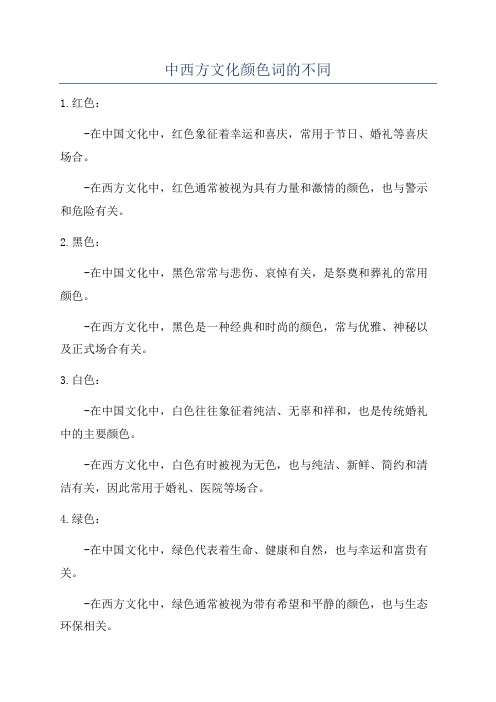
中西方文化颜色词的不同
1.红色:
-在中国文化中,红色象征着幸运和喜庆,常用于节日、婚礼等喜庆场合。
-在西方文化中,红色通常被视为具有力量和激情的颜色,也与警示和危险有关。
2.黑色:
-在中国文化中,黑色常常与悲伤、哀悼有关,是祭奠和葬礼的常用颜色。
-在西方文化中,黑色是一种经典和时尚的颜色,常与优雅、神秘以及正式场合有关。
3.白色:
-在中国文化中,白色往往象征着纯洁、无辜和祥和,也是传统婚礼中的主要颜色。
-在西方文化中,白色有时被视为无色,也与纯洁、新鲜、简约和清洁有关,因此常用于婚礼、医院等场合。
4.绿色:
-在中国文化中,绿色代表着生命、健康和自然,也与幸运和富贵有关。
-在西方文化中,绿色通常被视为带有希望和平静的颜色,也与生态环保相关。
除了上述颜色词的差异外,还有许多其他颜色在中西方文化中可能有不同的符号意义。
这些差异主要是由于历史、宗教、传统和文化背景的不同所导致的。
需要注意的是,这些差异并不是绝对的,个人对颜色的理解和喜好也可能存在差异。
- 1、下载文档前请自行甄别文档内容的完整性,平台不提供额外的编辑、内容补充、找答案等附加服务。
- 2、"仅部分预览"的文档,不可在线预览部分如存在完整性等问题,可反馈申请退款(可完整预览的文档不适用该条件!)。
- 3、如文档侵犯您的权益,请联系客服反馈,我们会尽快为您处理(人工客服工作时间:9:00-18:30)。
别,只有正确理解它们的情感色彩,才能领略英汉两种语言各具特色的文化内涵。
三、结语
自然界是五颜六色的世界,一般来讲,人类对色彩的感觉是相同的,但是,颜色一旦用
于人类社会的交际活动,在人们心目中就会产生特定的含义,引起特殊的联想,激发特别的
感情。各种所蕴含的寓意伴随着英汉民族在视觉和心理上所引发的联想象征意义而不尽相同。
可以说英汉颜色词体现了英汉民族丰富的文化内涵和迥异的文化心理,通过对颜色词的深入
研究,可以从一个角度透视英汉两种语言及两种文化的根本差异。所以了解并掌握颜色词在
英汉语言中的文化差异,对跨文化交际和英汉双语翻译研究意义深远。
一般常识是热天穿白色或淡色服装以反射阳光,冷天穿深色吸收热量。各国人穿衣有各自的
喜好与习俗,如在中国夏天一般穿白色或淡色的衣服,黑色很少有人穿;在英国约克市的女
子穿不同颜色的紧身衣向求婚男子示意:黄色表示有一半希望,绿色表示同意,红色表示不
同意。又如,中国人习惯用“米色”来描写淡黄色,皆因米是我们的主食,而英国人则以cream
后家属要穿白色孝服,办“白事”,胸襟上别着白色的小花,以此表达对死去亲人的哀悼和敬
意。
红色在中华民族的传统中是一种喜庆色,象征着吉祥、如意,使人联想到幸福与健康。
过新年时贴上红对联,举行婚礼时新娘都要穿上红色喜服,墙上、门上、窗上都贴上红喜字,
客人送的礼金或长辈给的红包,都要用红纸包着,结婚后生了孩子,有些地方还要向亲朋好
(奶油色)和 butter-yellow(黄油色)表示。这是由于汉英民族饮食习惯与生活习惯的不
同而产生的差异。
(五)情感色彩的差异
语言有一定的感情色彩,人们的感情色彩分为褒义、中性色词也不例外。比如blue(蓝色)一词,汉民族对其颇
有好感:蔚蓝色的天空,常能激发人们对未来的憧憬,蓝色的海洋常能勾起人们无限的遐想。
而这种情感色彩用在西方,如颇为流行的名曲“Love Is Blue”误解为“爱情是蓝色的”,却
不知此处的蓝色非但不能引发英美人的憧憬和遐想,反而会让人感到忧郁、沮丧。在英语中,
blue 通常表示不快,如in the blues(闷闷不乐), blue Monday(抑郁的星期一)。由此可
从颜色词看中英文化差异[外语教学与研究]
王富滨 约2522 字
摘 要: 本文从颜色词语的翻译角度探析了英汉两民族文化上的差异。这种差异主要体
现在历史传统、民族心理、宗教信仰、生活习惯和情感色彩等方面。语言学习者尤其要注意
造成对同一颜色词的看法形成巨大的反差。
(四)生活习俗的差异
在西方,人们崇尚 purple(紫色),古希腊、古罗马皇帝、执政官及将军都身着紫色,
紫色象征着显贵和尊严,象征着王位和王权,紫袍加身意味着上升到显赫的地位。而中国代
表显赫地位者所穿的是黄袍,是帝王君主的象征。同时习俗也是影响服饰最重要的因素之一。
主要障碍,所以了解这些文化差异,对语言学习者而言十分重要。
二、英汉颜色词的文化差异表现
(一)历史传统的差异
在英国人心目中,白色是上帝、天使、幸福、纯洁的象征。“西方人举行婚礼时,新娘要
穿白色的婚纱,这源自于英国国家的宗教故事,Magi 和 Draids 在基督复活时穿着白色的衣
服。因此,白色在西方国家被广泛地用在婚礼上。而白色在中国则是丧色。自古以来亲人死
为什么要如此变换色彩呢?这与他们的宗教想象分不开,蓝色代表他们来自天堂,黑色则代
表来自基督与黑暗使者的遭遇,红色与白色代表上帝的本性:智慧与爱。在中国,黄色是佛
教的经典,和尚、喇嘛的袈裟即为黄色,但犹大(《圣经》人物,传为出卖耶稣的人,是其门
徒之一)穿黄色衣服则是叛逆、嫉妒、懦弱的标志。由于英汉两民族在宗教信仰上的差异,
这些差异,尽量避免在跨文化交际中产生沟通障碍,以真正达到交际的目的。
关键词: 颜色词 中英文化差异 跨文化交际
一、引言
文化是一种复杂体,包括知识、信仰、艺术、道德、法律、风俗和其余社会上习得的能
力与习惯,它具有鲜明的民族性,亦即文化个性。不同的文化会呈现出不同的文化形态,这
种文化形态差异反映到语言层面上,则表现为语言差异。文化差异又是跨文化交际中的一个
同样的一种茶被描述成了不同的颜色?英国人着眼于茶叶的颜色,称其为“黑”,而中
国人则
着眼于茶水的颜色,称其为“红”,这是由于两民族之间观察事物的角度不同,看似矛盾的东
西,其实并不矛盾。再如,yellow(黄色)一词,黄色在中国封建社会里是法定的尊色,象
征着皇权、辉煌和崇高。黄色乃是“帝王之色”——古老中国的象征。具有这种文化心理的
人便很难想象,在英语文化里,黄色往往有忧郁、病态、令人讨厌、胆小的涵义。如:
yellow-bellied(胆怯的),a yellow streak(生性怯懦),yellow card(足球等运动中的
黄牌,由裁判员出示,用以向运动员提出警告),the yellow press(低级报刊,故作耸人听
友送红鸡蛋,以示喜庆。但在以英语为母语的英美民族中,红色则意味着流血、恐怖和危险,
甚至会使人联想到淫荡、低级趣味。如:现代西方城市有很多red light district(红灯区),
英语中的scarlet 有“鲜红的、淫荡的、罪名昭彰”之意。
由此可见,因历史传统的不同,英汉两民族对待颜色的态度也大相径庭,中国文化尚红
闻的报道以哗众取宠的报纸)等。
(三)宗教信仰的差异
英语中有些颜色的象征意义,受宗教影响颇深,颜色被赋予不同的宗教内涵与寓意。在
中世纪,教会指定艺术家在绘画时使用某些颜色。如圣母玛利亚的长袍要画成蓝色,在准备
式期间,基督的衣服要画成蓝色;在无知受到诱惑时,画成黑色;复活时画成红色或白色。
轻白,而英美文化则重白轻红。
(二)民族心理的差异
民族心理就像一条幽暗的地下长流,涌动在一个民族意识的岩层里,流贯在该民族的血
脉中。中西方人们的心理因素及看待问题的方式,往往存在着种种差异。英汉民族中,不同
的颜色词可能用于描述同一种物质的客观表象。英语说black tea,汉语说“红茶”。为什么
